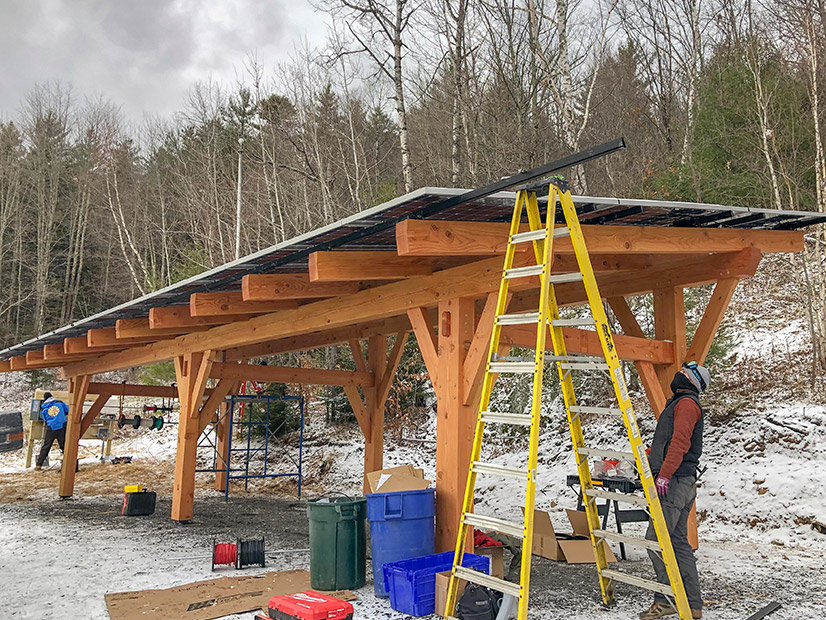Vermont regulators are taking another look at draft rules they issued in 2019 to overhaul the state’s net-metering and interconnection application processes.
The Vermont Public Utility Commission had released the draft rules with a request for input in two separate proceedings (19-0855-RULE, 19-0856-RULE). After comments were filed in each case, however, little happened until Green Mountain Power (GMP) asked the commission in January to restart the proceedings.
In a letter to the PUC, the utility said that the lack of clear net-metering and interconnection application processes “has created unnecessary friction between customers hoping to have solar installed without delay, their developers, and GMP.”
GMP cited concerns about the overlap between the state’s interconnection rule (5.500) and net-metering rule (5.100). It pointed to a recent case decision in which a hearing officer acknowledged that “the interplay between [the rules] is complex and has led to confusion on some cases.”
Siloing the two rules could simplify the application processes, Bill Jordan, director of engineering at the Vermont Department of Public Service, said Monday during a PUC workshop for the draft rules.
That “decoupling” would mean that the net-metering rule would point to the other rule for all the interconnection processes, he said.
GMP said that it had to seek resolution for a dispute with a developer because project review timelines are not clear. The developer expected a fast-tracked approval process, but GMP did not agree. The project was delayed, as the parties sought a decision on their dispute.
There is currently a “disconnect” between the rules governing project review times, according to Jordan.
Rooftop solar systems up to 500 kW have a 30-day review time, but if the project’s interconnection information is not filed, then the interconnection process will usually take more than 30 days from the time of filing.
The PUC’s draft net-metering rule would strip out ambiguous language and simply direct all net-metering applicants to demonstrate that they have completed an interconnection application and related reliability studies.
Flexible Structure
Updating the regulatory structure governing interconnection would allow regulators to keep up with market changes in the future, DPS Regulated Utility Planning Director Ed McNamara said.
One of the department’s concerns, he said, is that “things are evolving very quickly on the distribution level, especially with [distributed energy resources], and we’re looking at creating a structure that allows for flexibility going forward so we don’t have to come back to revisit the rule every six months or every year.”
The department has suggested that the interconnection rule be amended so that it only addresses minimum process requirements, while all technical requirements would be moved to a tariff filed by the state’s utilities.
A tariff approach would allow regulators to quickly update tariffs to address technical changes, such as NERC requirements or cybersecurity issues, McNamara said.
“The department’s main concern is that a rulemaking is a significant amount work and time, and a tariff provides a lot of the same protections for all of the stakeholders, with the same review, and allows a lot more flexibility,” he said.
Considering Storage
DPS staff said that while the draft interconnection rule adds energy storage as a generation resource to its definitions, there are many other storage issues to address in the proceeding.
“The interconnection of storage resources is becoming more of a consideration as we see more storage resources seeking to either couple with PV or other distributed generation resources or site in a stand-alone fashion,” Anne Margolis, deputy director of the DPS Planning Division, said.
Unlike solar, storage has a range of use cases, and it can toggle between use cases quickly, she said. How storage is used also can evolve based on emerging market opportunities. DPS is recommending that the commission seek input on how those cases are viewed for interconnection and whether the interconnection process ever needs to be revisited when the use cases change, Margolis said.
Storage is one of the most important interconnection issues that utility regulators around the country need to be focusing on, Sky Stanfield, a partner with Shute, Mihaly & Weinberger, said during the workshop on behalf of the Interstate Renewable Energy Council.
“It’s not that energy storage is that different from the basic technical review for solar, for example, but it is controllable in a way that solar and traditional generating resources historically were not,” she said.
The interconnection process needs to capture that control ability. Doing so encourages “the exact behavior that we want storage to perform on our systems,” such as discharging during peak hours, Stanfield said.
Up Next
Based on the input provided by participants in the workshop, the PUC plans to issue another request for comments and determine next steps once comments are submitted. Staff said it sees a need to set a phased rulemaking timeline.
A phased approach will allow the commission to lock in reforms already identified in the draft rule, such as project review timelines, and then move to new issues, such as energy storage and building a utility tariff for interconnections.



